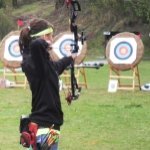Basic Archery
Step 9 - Release
On this page you will learn about the Release which is the ninth basic archery step of the shot sequence.
In this step you will learn the proper method of releasing the bowstring while you expand.
In this step the archer becomes totally committed to completing the shot cycle.
If all of the preceding steps are properly executed you should feel very comfortable and confident at this stage of the drawing cycle and be fully prepared to execute the shot.
My Archery Basics
Checklist
If your hand does not feel right on the bow, or you notice your elbow is not properly rotated, your shoulders are not pushed downward, your leaning back or away from the point of aim, or you feel your unbalanced (too much weight on one foot or leaning on the balls of your toes) or your head is rotated back or leaning toward the bow - LET DOWN!
Start the process over.
Again, this is the stage of the shot cycle where you are committed to full execution and making any corrections to your shooting form will be difficult to perform under the loads induced by the draw weight of the bow.
The release must be executed cleanly in a single smooth action.
Let's get started...
Before you begin this step you should check the following...
• After you aim, you should have re-focused on your overall form and checked the alignment of the bowstring with the upper limb on the bow.
Basic Archery Step 9: Release
- From the Aim and Expand step begin the release process by expanding further from the center of the chest outward toward your shoulders.
- The bow arm shoulder should remain stationary.
- The expansion of the chest should feel similar to taking a deep breath which rolls the major pectoral muscles outward (widening the chest).
- At the same time, allow the bowstring to leave your fingers.
- Push your fingers out of the way of the bowstring.
- Continue the expansion of your chest and increase the intensity of your back muscles at the same time.
- During the release, the scapula should continue to move toward the spine.
Coach's Corner
The process of releasing the bowstring is much more than merely opening the fingers.
The bowstring must be allowed to leave the finger tips cleanly and it is important to note that you are trying to allow the string to come off of your fingers straight in-line with the arrow.
If you snap the fingers open, the bowstring will not deviate from the straight path as much as when you slowly open your fingers and let the bowstring roll off the finger tips.
Open the fingers in a crisp but smooth motion.
Expansion: The expansion process is another concept that is difficult for the archer to grasp at first.
It is not uncommon for new archery students to shoot with what I call a dead-release.
That is, they fail to expand through the chest and increase the tension in the back muscles and it becomes obvious when the bowstring fingers remain at the side of the face.
In other words, the archer simply opens there bowstring fingers and there are no further movements in the drawing arm, shoulder or scapula.
A dead-release will eventually lead to "punching".
Punching is a condition where the archer rides the bowstring forward while opening the string fingers to release the bow string.
Under these circumstances the archer will be inconsistent at best and accuracy becomes a rarity.
In the early learning stages, remain focused on the actual process of expanding.
If you are uncertain what the expansion is, you can perform this simple exercise while sitting or standing to better understand the concept.
- Place each hand (open palm) flat on your major pectoral muscles (outside chest wall).
- Begin taking a long and very deep breath. Inhale slowly and deeply into your abdominal wall.
- Now slowly exhale and push the air from your lungs.
- As you repeat this several times you should feel your pectoral muscles roll to the outside of your chest. As this expansion continues you should also feel the sensation of your shoulders rolling around toward your back.
The difference will be that the bow arm shoulder remains stationary through the release; the drawing arm shoulder will expand as the scapula rolls around toward the spine.
In the beginning stages, remain focused on expanding and releasing the bowstring cleanly and less focused on where the arrow hits.
You will be rewarded in good time for your patience.
If you are a beginner or advanced archer and you are looking for a personal instructor, coach or trainer you can contact me directly.
What is the next basic archery step?
Go to Basic Archery Step 10 - Follow-Through
Go to previous Basic Archery Step 8 - Aim and Expand
Do You Have A Question About The Release Step?
Was This Page Helpful? Please Leave Your Feedback
Was This Page Helpful? Please Leave Your Feedback
Do you have a question about the basic archery step - Release? Or do you have an experience to share? Here is the place to ask your questions and share your experiences!
Home › Basic Archery › Step 9 - Release
![]()
Copyright © 2017 Learn-Archery.com All rights reserved
Learn-Archey.com is my personal site. It accepts advertising and other forms of compensation.
Such compensation
does not influence the information on this site. I always give my honest opinions, findings, beliefs, or experiences.












